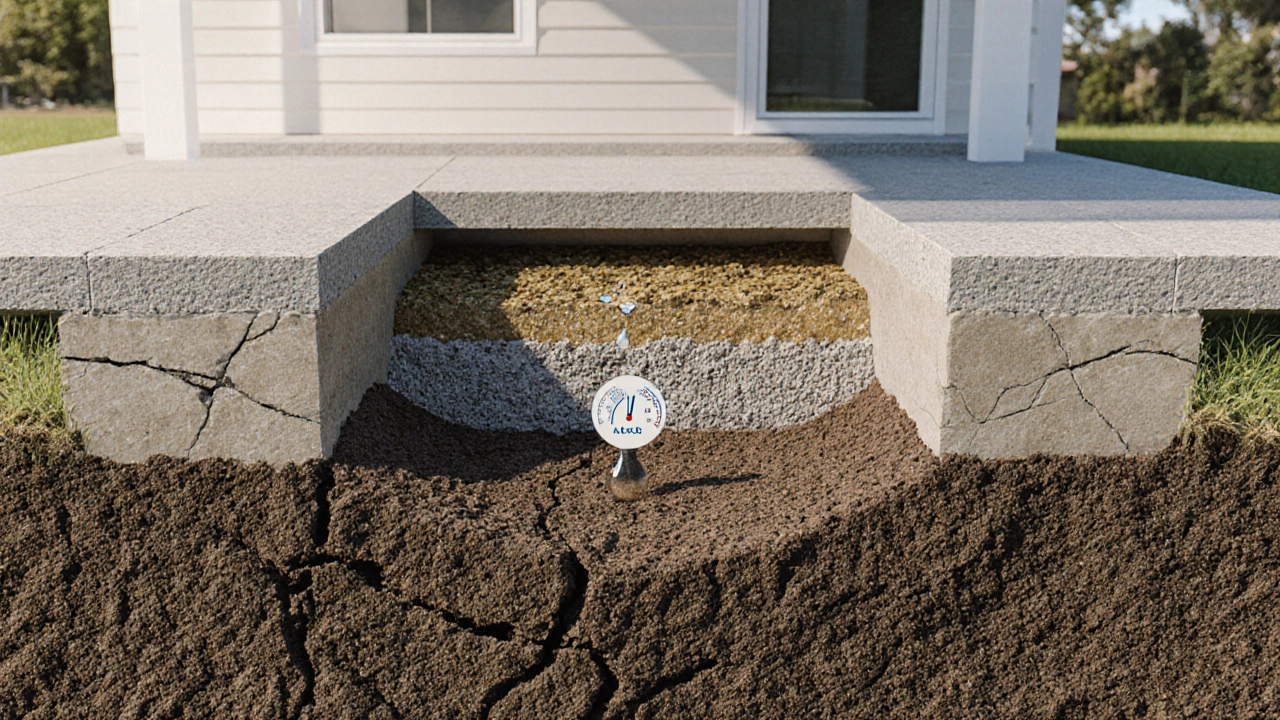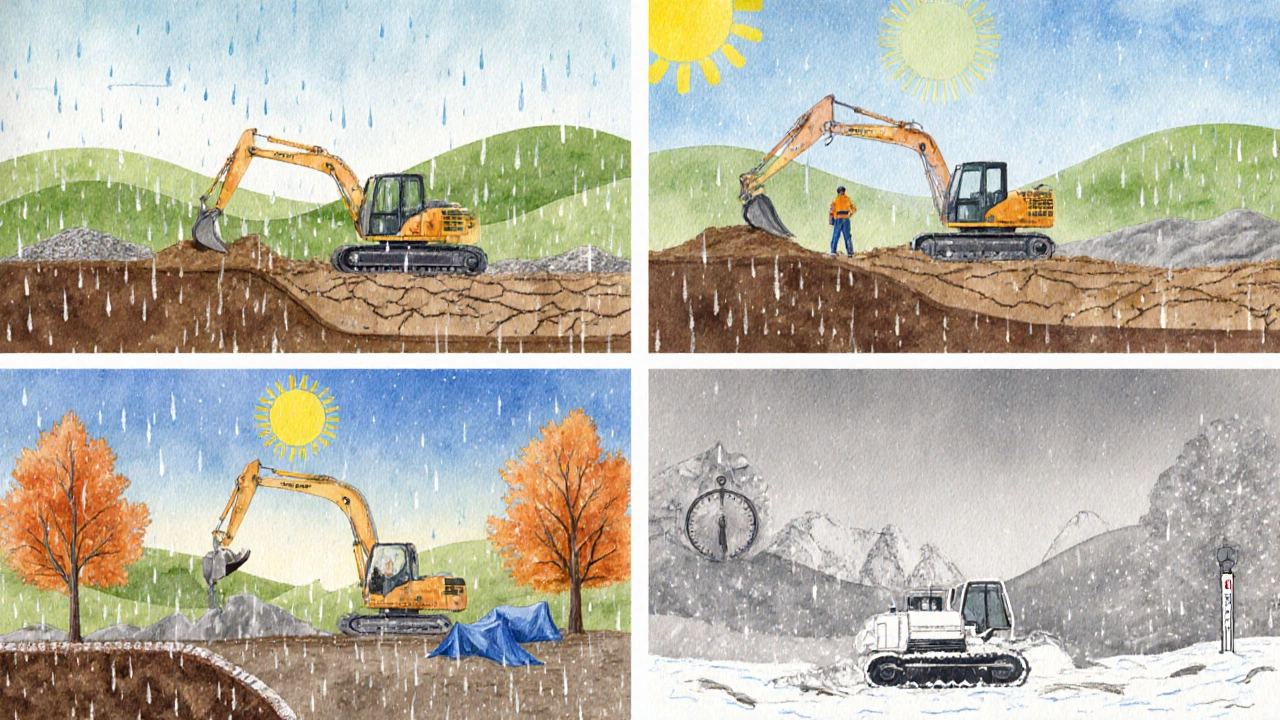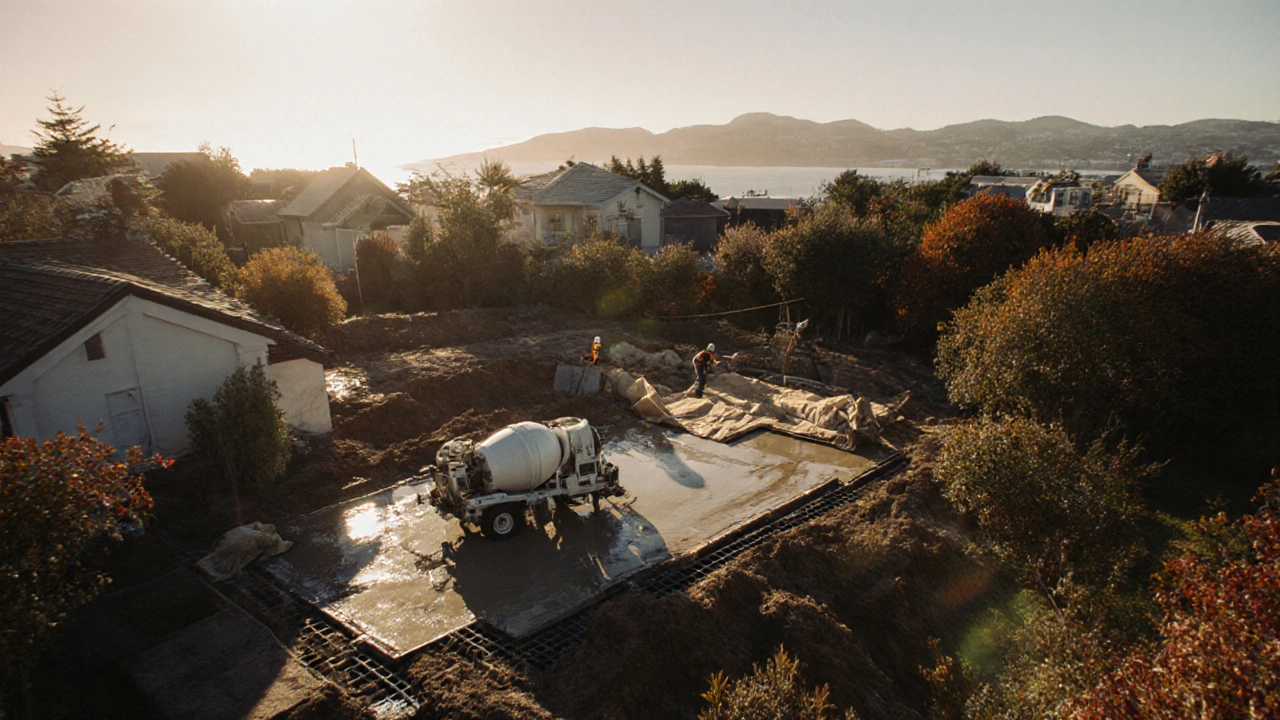Best Time of Year for Foundation Repair: Seasonal Guide
 Oct, 9 2025
Oct, 9 2025
Foundation Repair Season Selector
Select your region and soil type to get a recommendation.
Seasonal Breakdown
10°C - 18°C
Increasing Moisture
20°C - 30°C
Low Moisture
12°C - 20°C
Stable Moisture
5°C - 12°C (below 0°C in frost zones)
High or Frozen
When it comes to foundation repair is the process of correcting structural issues in a building's base to restore stability and prevent future damage, timing can be as critical as the work itself. Weather, soil conditions, and local climate patterns all shape how easy or hard a repair will be. Below we break down the science, the seasons, and the practical steps to pick the optimal window for your project.
Key Takeaways
- Dry, moderate temperatures (typically 10‑20°C) give the best working conditions.
- Spring and early autumn often provide the ideal balance of moisture and temperature.
- Avoid the peak of winter in frost‑prone areas and the height of summer in very hot, arid zones.
- Local soil type and drainage patterns are just as important as the calendar month.
- Plan inspections and permits at least 4‑6 weeks ahead of the chosen season.
How Weather Impacts Foundations
Foundations sit in direct contact with the ground, so they react to three main environmental factors:
- Soil moisture is the amount of water retained in the earth, influencing its load‑bearing capacity. Too wet, and soil can become soft; too dry, and it may shrink and pull away.
- Temperature governs how quickly concrete cures and how much the ground freezes.
- Precipitation patterns dictate when you’ll face flooding, runoff, or prolonged dampness.
In frost‑affected regions, the frost depth (how deep the ground freezes) can push against foundations, causing heave. In warm, dry climates, rapid drying can lead to shrinkage cracks. Understanding these forces helps you avoid starting a repair when nature is working against you.

Seasonal Pros and Cons
| Season | Temperature Range (°C) | Typical Soil Moisture | Key Advantages | Potential Drawbacks |
|---|---|---|---|---|
| Spring (Sept‑Nov) | 10‑18 | Increasing but manageable | Ground softens enough for excavation; moderate temps speed up concrete cure. | Rain spikes can delay work; must monitor drainage. |
| Summer (Dec‑Feb) | 20‑30 | Generally low | Fast drying allows quick back‑filling; long daylight hours. | Excessive heat can cause rapid concrete shrinkage; water restrictions may apply. |
| Autumn (Mar‑May) | 12‑20 | Stable, cooling | Ideal balance of moisture and temperature; cooler evenings aid concrete strength. | Late‑season rain can become unpredictable; shorter days. |
| Winter (Jun‑Aug) | 5‑12 (may drop below 0 in frost zones) | High or frozen | If frost‑free, low humidity reduces shrinkage. | Frozen ground halts excavation; frost heave can undo repairs. |
For most temperate regions-including Wellington, New Zealand-spring and early autumn consistently rank highest. The soil is moist enough to dig without overly soft conditions, yet temperatures stay above the freezing point, allowing concrete to cure properly.
Regional Nuances: Wellington and Similar Climates
Wellington experiences mild, maritime weather: average highs hover around 14‑16°C year‑round, with rainfall spread evenly across months. Because frost is rare, the primary concern is excessive rain rather than freezing.
- **Rainfall Peaks**: June to August see the highest precipitation. Schedule major excavation after a dry spell of 5‑7 days.
- **Sea‑Breeze Humidity**: High humidity can slow concrete curing. Use additives like accelerators if you must work in late summer.
- **Soil Type**: Much of Wellington sits on volcanic ash and loam, which retain water well. Ensure proper drainage is installed to prevent future moisture buildup.
In drier interior regions of New Zealand, summer becomes more favorable, while in the South Island’s colder zones, aim for late spring to early autumn before frost depth exceeds 30cm.
Planning Your Repair Project
- Inspection & Assessment: Hire a qualified structural engineer to pinpoint cracks, settlement, and water intrusion.
- Obtain Permits: Local councils often require a building consent for extensive underpinning or wall replacement. Start the paperwork at least a month before the intended start date.
- Choose a Contractor: Look for companies with proven experience in your climate zone. Ask for references where work was completed in similar seasonal conditions.
- Schedule Around Weather: Use a short‑term forecast tool to lock in a 2‑3 week window free of heavy rain.
- Prepare the Site: Clear vegetation, set up proper drainage, and protect neighboring structures from vibration.
- Monitor Curing: Concrete should stay moist for the first 48‑72hours. In dryer seasons, cover with wet burlap or use curing compounds.

Common Pitfalls & How to Avoid Them
- Rushing During a Heat Wave: High temps accelerate evaporation, leading to weak concrete. Pause work if temperatures exceed 30°C for extended periods.
- Ignoring Soil Reports: A soil test can reveal expansive clay that swells with moisture. If present, incorporate moisture‑control membranes.
- Under‑estimating Rain Delays: Build a buffer of at least one week into your schedule. Have a tarp or temporary cover ready for exposed foundations.
- Skipping Back‑filling Compaction: Proper compaction prevents future settlement. Use a plate compactor in layers no thicker than 150mm.
- Neglecting Post‑Repair Drainage: Install French drains or perimeter weeping tiles to channel water away from the repaired area.
Quick Pre‑Repair Checklist
- Soil moisture level within target range (10‑15% for most loam soils).
- Temperature forecast: steady 10‑20°C for at least 5 consecutive days.
- Permits approved and on‑site.
- Contractor confirmed with seasonal experience.
- Materials on hand: concrete mix, waterproofing membranes, compaction tools.
- Weather contingency plan (tarps, drainage diversions).
FAQs
Is winter ever a good time for foundation repair?
In frost‑free climates like most of New Zealand, winter can work if the ground stays unfrozen and rain is limited. However, frozen soil stops excavation, and low temperatures slow concrete curing, so it’s usually a backup option.
How does heavy rain affect the repair process?
Excess water can saturate the trench, making shoring unsafe and diluting concrete mixes. After a rain event, allow the site to dry for 24‑48hours before resuming work.
Do I need a structural engineer for a simple crack repair?
Even small vertical cracks can signal deeper settlement. A qualified engineer can determine whether a crack is superficial or requires underpinning, saving you costly re‑work later.
What is the best concrete mix for foundation work?
A mix with a minimum 30MPa compressive strength, low water‑cement ratio, and air‑entraining agents for freeze‑thaw resilience is ideal. In humid seasons, add a curing compound to retain moisture.
Can I do foundation repair myself?
Minor crack stitching might be DIY‑friendly, but most foundation issues involve structural changes, soil interaction, and waterproofing-tasks best left to licensed professionals.
